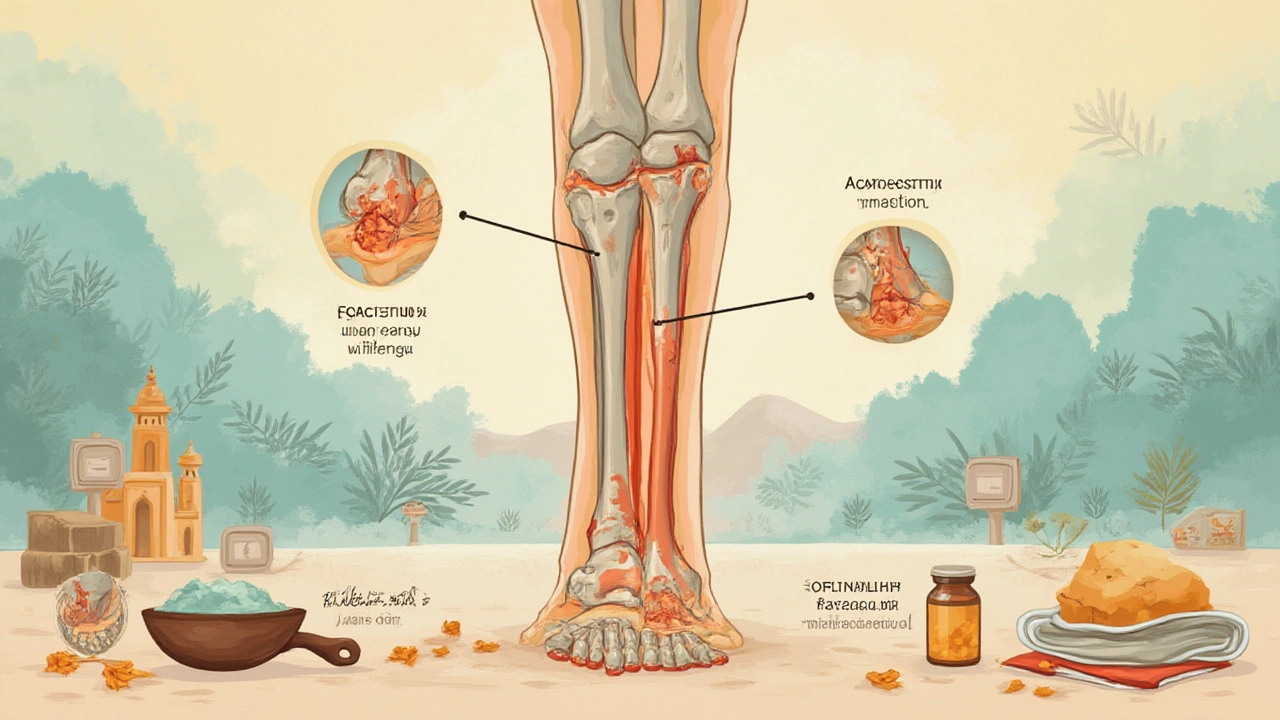
Bones are supposed to keep us upright, moving, and adventuring—till suddenly, with one wrong move, plans come crashing down. If you play soccer, help a friend move house, or just slip while chasing your dog (shout-out to Charlie, who’s responsible for at least two of my minor sprains), you know bones can be overconfident. Want to guess what brings the most people sprinting (or hobbling) to the orthopedic ER? It’s not twisted ankles, ugly dislocations, or even muscle tears. The real headliner: fractures. Broken bones hog the orthopedic spotlight way more than you think.
Why Fractures Top the Emergency Charts
About 6.8 million people in the United States snap a bone every year—roughly one fracture every five seconds. These numbers tick upward when you factor in sports, car accidents, falls, and everyday whoops moments. But why are fractures so common? Our bones are tough, but they’re still just living tissue. Put enough force on them (think direct hit, awkward twist, or high-speed crash), and something's bound to give. Arms and wrists lead the list, courtesy of people bracing themselves during falls. Kids, thanks to wild playground antics, often break forearms; older adults, due to thinning bones (osteoporosis), often end up with hip or wrist fractures from even the gentlest of tumbles.
Take a look at this table that shows the most common fracture sites by age group:
| Age Group | Most Common Fracture Site |
|---|---|
| Children (0-12) | Forearm |
| Teenagers (13-19) | Clavicle (collarbone) |
| Adults (20-50) | Wrist |
| Seniors (50+) | Hip |
The truth is, accidents don’t discriminate. Anything from missing a stair (done that), to getting blindsided at football, or tripping over Charlie’s chew toy can put you in a cast fast. But not all fractures are high drama. Sometimes there’s no dramatic crack—stress fractures creep up with repetitive strain, so they’re sneaky and often missed till the pain refuses to chill. The mix of causes is why fractures stay the most common orthopedic emergency everywhere in the world.
Types of Fractures and Why They Matter
Let’s break down (pun intended) how fractures can differ. The picture you probably see on TV—a bone sticking out (ick)—is just one type, called an open or compound fracture. But most fractures are more subtle. Here are the usual suspects:
- Simple (closed) fracture: Bone snaps but doesn’t poke through the skin. Most common and less likely to get infected.
- Compound (open) fracture: The bone breaks and breaks through the skin. High risk for infection, needs urgent care.
- Greenstick fracture: Kids get these a lot—their bones bend and crack, but don’t snap all the way.
- Comminuted fracture: The bone breaks into three or more pieces. Usually from big trauma like car crashes or high falls.
- Stress fracture: Tiny cracks from repetitive action. Runners, dancers, soldiers—watch out.
Fractures aren’t just about pain—they can mess with nerves, blood vessels, and sometimes even organs nearby. For example, a broken femur (thighbone) isn’t just a leg issue. Since the femur is packed with blood vessels, losing blood inside your leg can actually lead to shock. Pretty scary stuff if you don’t get help fast.
The fracture type often shapes the treatment. Simple wrist breaks might just need a cast. Collarbones usually heal with a sling, unless the pieces drift too far apart. But hip fractures—solidly the worst for older folks—almost always mean surgery. They’re so serious that data shows 1 in 3 people over age 65 who break a hip have trouble ever living on their own again. No wonder doctors get twitchy about any kind of fracture.

How to Spot a Fracture (and What to Do Right Away)
Missed a step? Landed funny? Your arm or leg suddenly looks weird? There are telltale signs of a fracture, but not every break comes with dramatic swelling or a visible bump. Watch for:
- Sudden, sharp pain that gets worse with movement or pressure.
- Swelling or bruising forming within minutes.
- Deformity—think a limb looking twisted, bent, or shortened.
- A grinding or pop at the time of injury (don’t try to recreate it, please).
- Numbness, tingling, or loss of movement below the suspected break point.
- Open wounds with bone peeking through (clear ER territory).
If you ever think something’s broken, don’t try to “walk it off” or jab it back in place. Here’s what you should do:
- Keep the injured area still—improvise a splint with anything stiff (like a magazine or a stick) to prevent unnecessary movement.
- Apply ice over a cloth to minimize swelling.
- If there’s bleeding, press gently with a clean cloth, but don’t push hard over a bone sticking out.
- Keep the limb elevated if possible, but don’t force any movement.
- Head to urgent care or an ER pronto for x-rays and the right fix.
Begging your doctor for painkillers or worrying about hospital bills might cross your mind, but don’t delay getting checked. Even a tiny fracture can grow into a monster problem if it heals wrong. Plus, open fractures—where the bone breaks skin—are true emergencies due to infection risk, so don’t tough it out.
How Doctors Handle Orthopedic Fractures in Emergencies
So what actually happens once you roll into the ER with a fracture? First off, doctors focus on pain control—a quick shot or pill makes things less miserable. Next, they’ll ask how the injury happened (to rule out hidden damage) and quickly inspect for pulses, sensation, and movement downstream. This checks if blood flow or nerves got squished or severed.
X-rays are non-negotiable. For trickier spots (like the wrist or ankle), you might even get a CT scan. This isn’t just for fun—it helps spot hairline breaks or figure out if surgery is needed. Once they know the details, doctors make a call:
- Non-surgical treatments: Simple breaks usually get immobilized. This means plaster/fiberglass casts, splints, boots, or slings. The goal is to hold bones exactly where they were at the split-second of injury, so they knit together straight. For kids’ greenstick fractures, a little straightening may be all it takes.
- Surgery: If bones are misaligned, shattered in pieces, or broke through the skin, the operating room is next. Surgeons might use metal pins, plates, rods, or screws—think internal scaffolding. Sometimes ‘external fixation’ is used, where screws stick out the skin and connect to a frame. It looks wild but allows for swelling and better monitoring.
The average hospital stay for a simple broken wrist or arm is a few hours. But hefty breaks—like compound leg fractures—can mean a week or more in the hospital, and then months of recovery. Rehab is its own beast. Physical therapy keeps muscles from wasting away and joints from stiffening. Without it? Even a fixed bone could leave you hobbling, weaker than before.
Doctors always stress early motion once it’s safe. Babies are crawling, runners are itching to jog, and even grumpy old dogs (looking at you, Charlie) want to get moving again. But patience is key—the strongest bone is the one that heals right, not fastest. Rushing back before things are solid can mean everything shifts out of place, and round two of surgery comes calling. Nobody wants that.

Pro Tips for Avoiding Fractures and Dealing With Recovery
The stats are wild: about 50% of women and 25% of men will break a bone due to osteoporosis after age 50. But everyone—teens, athletes, dog walkers—have a shot at a fracture just by living. While you can’t dodge every accident, there are real ways to stack the odds in your favor.
- Boost your bone strength: Get enough calcium and vitamin D, not just from pills but also from dairy, leafy greens, or fortified foods.
- Exercise regularly, especially weight-bearing stuff like walking, jogging, or jumping. Bones get denser when you give them a reason.
- Don’t ignore your balance—yoga, tai chi, and even dancing protect your ability to catch yourself if you stumble.
- Rethink your home: Rugs, loose cords, wet tiles, and even dog toys (guilty!) are classic trip hazards. A little cleanup goes a long way.
- Wear the right gear for whatever you do—helmets for biking, guards for skating, shoes with good grip for hiking.
- Watch for signs of stress fractures—persistent pain after activity, swelling, or pain at night.
After a fracture, don’t be a hero. Stick to physical therapy, take the full rest time, and tell your doctor if you notice new pain or swelling. Bone typically takes 6-8 weeks to knit, longer if you smoke or have health issues. Kids get back on the playground fastest, but older adults might need extra help with daily stuff for a while—check in on grandparents, and keep them active but safe.
Here’s a table showing recovery time and complications by fracture type:
| Fracture Type | Average Healing Time | Common Complications |
|---|---|---|
| Wrist | 6-8 weeks | Stiffness, malunion |
| Hip | 12 weeks+ | Loss of mobility, infections |
| Femur | 3-6 months | Blood loss, muscle wasting |
| Clavicle | 6-8 weeks | Nonunion, nerve injury |
| Vertebrae | 8-12 weeks | Paralysis (rare), chronic pain |
Don’t forget regular follow-ups—even if you feel okay, only an x-ray can confirm everything’s lined up. If you have pets like my dog Charlie, just know you’re always one paw away from an ER visit, so keep your reflexes sharp and both eyes on the floor.
Fractures might rule the orthopedic emergency kingdom, but most heal up well with quick action and a dash of patience. Knowledge is power—knowing what causes breaks, how to spot them, and what to do next, could mean getting back to your life (and unruly pets) that much sooner.





